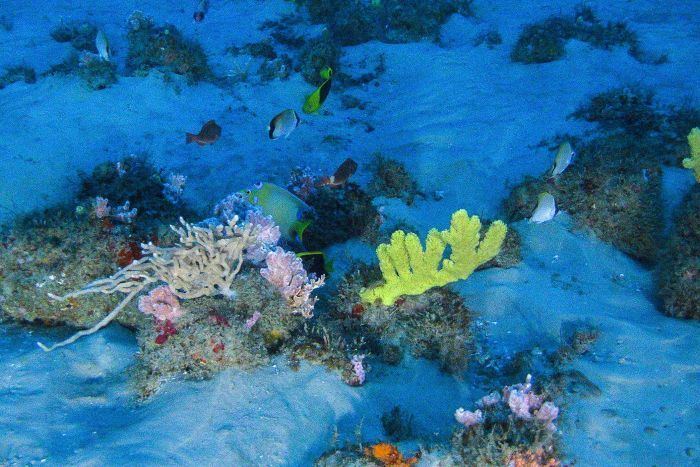 | ||
First ever underwater images of the amazon reef
The Amazon Reef (also referred to as the Amazonian Reef) is an extensive coral and sponge reef system, located in the Atlantic Ocean off the coast of French Guiana and northern Brazil. It is one of the largest known reef systems in the world, with scientists estimating its length at over 970 kilometres (600 miles), and its area as over 9,300 km2 (3,600 sq mi). Publication of its discovery was released in April 2016, following an oceanographic study of the region in 2012. Evidence of a large structure near the delta of the Amazon River dated from as early as the 1950s.
Contents
- First ever underwater images of the amazon reef
- Geography and ecology
- Discovery
- Environmental threats
- References
Geography and ecology
Referred to as either the Amazon Reef or the Amazonian Reef, the reef system has been identified as a coral and sponge reef. Scientists estimated the reef's size to be 9,300 km2 (3,600 sq mi) in area, and over 970 km (600 mi) in length, making it one of the largest reef systems in the world, comparable to the size of the island of Cyprus. Another estimate also puts the general ecoregion encompassing the reef to be as large as 14,480 km2 (5,592 sq mi). The reef's area extends as far as 120 km (75 mi) offshore, and is estimated to lie in waters ranging from 30 to 120 metres (100 to 400 feet) deep. The reef's existence is unusual, as reef systems do not often exist in the mouths of larger rivers like the Amazon, due to the low salinity and high acidity, in addition to the continuous rain of sediments. Before the reef's discovery, it was originally believed that the Amazon, with its sediment-rich plume, represented a significant gap in reef distribution across the Western Atlantic, correlating with the accepted view that corals thrived in clear waters along tropical shelves. The reef primarily owes its existence to its depth, as it is below the freshwater layer of discharge from the Amazon into the Atlantic Ocean, a discharge that represents one fifth of the outflow into the Earth's oceans.
The majority of the reef is made up of beds of rhodolith, various species of red algae, which superficially resemble coral. While it has been described as "impoverished", and "not having the biodiversity of some of the more prominent coral reefs of the world", 61 species of sponge and 73 species of fish, in addition to various coral and star species, have so far been identified as inhabiting the reef, including staghorn corals, and spiny lobsters. Pockets of coral species, discovered as early as 1999, were found to be similar to those found in the Caribbean Sea, hinting at the possibility that Caribbean corals dispersed to the Amazon Reef. Marine biologists have also entertained the idea that the reef serves as a stepping stone to facilitate dispersal of species from reefs in southern Brazil northwards to the Caribbean. The biology of the reef is mostly dictated by the discharge of the Amazon into the Atlantic. Northern sections of the reef are often shrouded in the shadow of the sediment layer above for half a year on average, producing an environment similar to a "shadow zone". These northern areas are populated with sponges and carnivorous species such as hydroids. Southern sections of the reef, which are covered by the Amazon's plume only three months a year on average, are more populated with diverse coral-centric life, where photosynthesis can occur. It is believed that single-celled organisms are central to the reef's ecosystem, providing the main source of nutrients to sponges, corals and other inhabitants. Fabiano Thompson, along with other researchers on the reef, describe the system as a new class of biome.
Discovery
Initial evidence for a coral and sponge reef system in the Amazon Delta region first surfaced in the late 1950s, when a U.S. survey ship collected sponges from the floor of the Amazon Delta. Further evidence also appeared in 1977, when reef fish were first sighted in the area, and in 1999, when Caribbean-native coral species were found in isolated regions near the Amazon Delta. However, no major study into the existence of a reef system occurred until 2012, when an international research team of over 30 oceanographers, led by Rodrigo Moura of the Federal University of Rio de Janeiro, and including patrons from the University of Georgia, conducted a survey of the area aboard the RV Atlantis. The survey was mostly based on findings from the 1970s, including a crude map of the area marked with potential locations of reefs along the Amazonian coast. The team used technologies such as acoustic sampling to locate potential reef sites, and confirmed the discovery by dredging the floor of the reef, bringing up samples of corals, sponges and other reef species onto the ship deck. Their discoveries and findings were detailed and presented in a research article, published in the scientific journal Science Advances, in April 2016.
Environmental threats
Since its discovery, multiple environmental threats to the reef's ecosystem have been identified, including pollution and overfishing, and rising ocean acidification and temperature as a result of recent acceleration in climate change, which also affects various reefs around the world. A more immediate threat, however, are the numerous oil exploration projects operating nearby or on the reef itself. In the past decade, the Brazilian government had sold 80 license blocks to oil energy companies in the region, with an environmental baseline based on "sparse museum specimens". Twenty of these blocks are already producing oil.
